Computer Networking > EXAM > Chapter 7 Wireless LANS II > Business Data Networks and Security, 11e (Panko) > Clean {A} Latest Exa (All)
Chapter 7 Wireless LANS II > Business Data Networks and Security, 11e (Panko) > Clean {A} Latest Exam.
Document Content and Description Below
Business Data Networks and Security, 11e (Panko) Chapter 7 Wireless LANS II 1) Nearly all public Wi-Fi hotspots encrypt your transmissions. Answer: FALSE Difficulty: Basic Question: 1a Objective: Expl... ain 802.11i Wi-Fi security. AACSB: Applying Information Technology 2) If a drive-by hacker succeeds in connecting to an internal access point, the network traffic is ________. A) still protected by a firewall B) still protected by encryption C) both A and B D) neither A nor B Difficulty: Basic Question: 1d Objective: Explain 802.11i Wi-Fi security. AACSB: Applying Information Technology, Analytical Thinking, Application of Knowledge 3) 802.11i provides ________. A) confidentiality B) message integrity C) both A and B D) neither A nor B Difficulty: Basic Question: 2a Objective: Explain 802.11i Wi-Fi security. AACSB: Applying Information Technology 4) In 802.11i, protection is provided between the client and the ________. A) access point B) switch C) router D) server Difficulty: Basic Question: 2b Objective: Explain 802.11i Wi-Fi security. AACSB: Applying Information Technology, Application of Knowledge 5) The protection of communication between a wireless client and the access point is ________. A) link security B) end-to-end security C) both A and B D) neither A nor B Difficulty: Basic Question: 2c Objective: Explain 802.11i Wi-Fi security. AACSB: Applying Information Technology, Application of Knowledge 6) The Wi-Fi Alliance calls 802.11i ________. A) WEP B) WPA C) WPA2 D) none of the above Difficulty: Basic Question: 2d Objective: Explain 802.11i Wi-Fi security. AACSB: Applying Information Technology 7) Which offers stronger security? A) WPA B) 802.11i C) both A and B offer equally strong security. Difficulty: Basic Question: 2e Objective: Explain 802.11i Wi-Fi security. AACSB: Applying Information Technology, Application of Knowledge 8) What is the strongest security protocol for 802.11 today? A) 802.11s B) 802.11X C) WPA D) 802.11i Difficulty: Basic Question: 2e Objective: Explain 802.11i Wi-Fi security. AACSB: Applying Information Technology, Application of Knowledge 9) 802.11i PSK initial authentication mode was created for ________. A) corporations with multiple access points B) residences with a single access point C) residences with less than eight access points D) corporations with less than eight access points Difficulty: Basic Question: 3a Objective: Explain 802.11i Wi-Fi security. AACSB: Applying Information Technology 10) 802.11i 802.1X initial authentication mode was created for ________. A) corporations with multiple access points B) residences with a single access point C) residences with less than eight access points D) corporations with less than eight access points Difficulty: Basic Question: 3a Objective: Explain 802.11i Wi-Fi security. AACSB: Applying Information Technology 11) Communication after authentication is protected most strongly if the ________ initial authentication is used. A) PSK B) 802.1X C) WPA D) It does not matter which initial authentication mode is used. Difficulty: Deeper Question: 3c Objective: Explain 802.11i Wi-Fi security. AACSB: Applying Information Technology, Application of Knowledge 12) In 802.11i ________, hosts must know a shared initial key. A) 802.1X initial authentication mode B) PSK initial authentication mode C) both A and B D) neither A nor B Difficulty: Basic Question: 4b Objective: Explain 802.11i Wi-Fi security. AACSB: Applying Information Technology, Application of Knowledge 13) After authentication in 80.11i PSK mode, a wireless client communicates with the access point via a(n) ________ key. A) VPN B) pairwise session C) 802.1X D) preshared Difficulty: Basic Question: 4c Objective: Explain 802.11i Wi-Fi security. AACSB: Applying Information Technology, Application of Knowledge 14) After two wireless clients authenticate themselves via PSK to an access point, they will use ________ to communicate with the access point. A) the preshared key B) an 802.1X key C) WPA keys D) different pairwise session keys Difficulty: Deeper Question: 4C Objective: Explain 802.11i Wi-Fi security. AACSB: Applying Information Technology, Application of Knowledge 15) Which of the following is a risk in 802.11i PSK mode? A) Unauthorized sharing of the pre-shared key. B) A weak passphrase may be selected. C) both A and B D) neither A nor B Difficulty: Basic Question: 4d Objective: Explain 802.11i Wi-Fi security. AACSB: Applying Information Technology, Application of Knowledge 16) In 802.11i PSK mode, the pass phrase should be at least ________ characters long. A) 8 B) 12 C) 20 D) 128 Difficulty: Basic Question: 4f Objective: Explain 802.11i Wi-Fi security. AACSB: Applying Information Technology 17) If a firm has many access points, it should use ________ initial authentication mode in 802.11i. A) PSK B) 802.1X C) IPsec D) WPA Difficulty: Basic Question: 5a Objective: Explain 802.11i Wi-Fi security. AACSB: Applying Information Technology, Application of Knowledge 18) In what initial authentication mode of 802.11i is a central authentication server used? A) 802.1X B) PSK C) both A and B D) neither A nor B Difficulty: Basic Question: 5b Objective: Explain 802.11i Wi-Fi security. AACSB: Applying Information Technology, Application of Knowledge 19) In 802.1x initial authentication mode, the authenticator is the ________. A) wireless client B) wireless access point C) authentication server D) none of the above Difficulty: Basic Question: 5d Objective: Explain 802.11i Wi-Fi security. AACSB: Applying Information Technology, Application of Knowledge 20) In 802.1x initial authentication mode, the VERIFIER is the ________. A) wireless client B) wireless access point C) authentication server D) none of the above Difficulty: Deeper Question: 5d Objective: Explain 802.11i Wi-Fi security. AACSB: Applying Information Technology, Analytical Thinking, Application of Knowledge 21) What initial authentication mode does 802.11i use? A) 802.1X B) PSK C) both A and B D) neither A nor B Difficulty: Deeper Question: 6a Objective: Explain 802.11i Wi-Fi security. AACSB: Applying Information Technology, Analytical Thinking, Application of Knowledge 22) Which initial authentication mode is used for message-by-message encryption, authentication, and message integrity? A) 802.1X B) PSK C) both A and B D) neither A nor B Difficulty: Deeper Question: 6b Objective: Explain 802.11i Wi-Fi security. AACSB: Applying Information Technology, Analytical Thinking, Application of Knowledge 23) A ________ is an unauthorized internal access point. A) binky B) shadow C) rogue D) none of the above Difficulty: Basic Question: 7a Objective: Explain why 802.11i Wi-Fi security is not enough for WLANs. AACSB: Applying Information Technology, Application of Knowledge 24) A rogue access point is usually created by ________. A) an employee B) an external attacker C) the IT security department D) an evil twin Difficulty: Deeper Question: 7a Objective: Explain why 802.11i Wi-Fi security is not enough for WLANs. AACSB: Applying Information Technology, Application of Knowledge 25) 802.11i can defeat rogue access points. Answer: FALSE Difficulty: Basic Question: 7b Objective: Explain why 802.11i Wi-Fi security is not enough for WLANs. AACSB: Applying Information Technology, Application of Knowledge 26) Employees who set up rogue access points usually have malicious motives. Answer: FALSE Difficulty: Deeper Question: 7c Objective: Explain why 802.11i Wi-Fi security is not enough for WLANs. AACSB: Applying Information Technology, Application of Knowledge 27) An evil twin access point is usually ________. A) a database B) a laptop computer C) a calculator D) a spreadsheet Difficulty: Deeper Question: 8a Objective: Explain why 802.11i Wi-Fi security is not enough for WLANs. AACSB: Applying Information Technology, Application of Knowledge 28) If a company uses 802.11i for its core security protocol, an evil twin access point will set up ________ 802.11i connection(s). A) one B) two C) four D) none of the above. Difficulty: Basic Question: 8a Objective: Explain why 802.11i Wi-Fi security is not enough for WLANs. AACSB: Applying Information Technology, Analytical Thinking, Application of Knowledge 29) When a wireless client in an evil twin attack transmits, ________. A) the evil twin reads the packet, encrypts it, and passes on the packet B) the evil twin reads the frame, encrypts it, and passes on the frame C) the evil twin reads the packet and passes on the packet D) the evil twin reads the frame and passes on the frame Difficulty: Deeper Question: 8b Objective: Explain why 802.11i Wi-Fi security is not enough for WLANs. AACSB: Applying Information Technology, Application of Knowledge 30) Which of the following is usually set up by a hacker outside the building? A) a rogue access point B) an evil twin access point C) both A and B D) neither A nor B Difficulty: Deeper Question: 8c Objective: Explain why 802.11i Wi-Fi security is not enough for WLANs. AACSB: Applying Information Technology, Analytical Thinking, Application of Knowledge 31) Which of the following secures communication between the wireless computer and the server it wishes to use against evil twin attacks? A) VLANs B) VPNs C) 802.1X mode D) none of the above Difficulty: Basic Question: 8d Objective: Explain why 802.11i Wi-Fi security is not enough for WLANs. AACSB: Applying Information Technology, Application of Knowledge 32) In VPNs designed to frustrate evil twin attacks, the shared secret between the client and the server is ________. A) transmitted in the clear B) transmitted with cryptographic protections C) not transmitted D) any of the above Difficulty: Basic Question: 8d Objective: Explain why 802.11i Wi-Fi security is not enough for WLANs. AACSB: Applying Information Technology, Analytical Thinking, Application of Knowledge 33) A VPN provides ________. A) link security B) end-to-end security C) comprehensive security D) none of the above Difficulty: Basic Question: 8e Objective: Explain why 802.11i Wi-Fi security is not enough for WLANs. AACSB: Applying Information Technology, Analytical Thinking, Application of Knowledge 34) You can test whether an evil twin attack has taken place against your wireless client. Answer: FALSE Difficulty: Deeper Question: 8e Objective: Explain why 802.11i Wi-Fi security is not enough for WLANs. AACSB: Applying Information Technology, Analytical Thinking, Application of Knowledge 35) You should use a VPN ________. A) if you know that an evil twin access point is in use. B) if you know that your device has been compromised by an evil twin attack. C) always D) never Difficulty: Deeper Question: 8f Objective: Explain why 802.11i Wi-Fi security is not enough for WLANs. AACSB: Applying Information Technology, Analytical Thinking, Application of Knowledge 36) Selecting locations for access points first involves ________. A) laying out circles of a chosen diameter in a diagram of the building B) doing a wireless site survey C) selecting locations that reflect organizational units D) all of the above Difficulty: Basic Question: 9a Objective: Discuss 802.11 WLAN management. AACSB: Applying Information Technology 37) Site surveys should be done ________. A) after the initial provisional placement of access points B) periodically afterwards C) both A and B D) neither A nor B Difficulty: Basic Question: 9b Objective: Discuss 802.11 WLAN management. AACSB: Applying Information Technology, Application of Knowledge 38) A security might use SNMP Get commands to ________. A) change an access point's power B) collect information to look for a rogue access point C) both A and B D) neither A nor B Difficulty: Basic Question: 10a Objective: Discuss 802.11 WLAN management. AACSB: Applying Information Technology, Analytical Thinking, Application of Knowledge 39) A security might use SNMP Set commands to ________. A) change an access point's power B) collect information to look for a rogue access point C) both A and B D) neither A nor B Difficulty: Basic Question: 10a Objective: Discuss 802.11 WLAN management. AACSB: Applying Information Technology, Analytical Thinking, Application of Knowledge 40) Centralized access point management ________. A) increases management costs but provides better control B) reduces management costs Difficulty: Basic Question: 10c Objective: Discuss 802.11 WLAN management. AACSB: Applying Information Technology, Application of Knowledge 41) Which is the correct formula for decibels? A) 10 * P2/P1 B) 10 * (P2/P1)2 C) Log10(P2/P1) D) none of the above Difficulty: Basic Question: 11a Objective: If you have read the More Information box, "Expressing Power Ratios in Decibels," be able to do so. AACSB: Applying Information Technology, Analytical Thinking, Application of Knowledge 42) Compared to an omnidirectional antenna, a dish antenna quadruples radiated power. How much is this change in decibels? A) 6 dB B) 9 db C) 16 db D) none of the above Difficulty: Deeper Question: 11b Objective: If you have read the More Information box, "Expressing Power Ratios in Decibels," be able to do so. AACSB: Applying Information Technology, Analytical Thinking, Application of Knowledge 43) An 8/1 increase in power corresponds to approximately ________ decibels. A) 3 B) 6 C) 20 D) none of the above Difficulty: Deeper Question: 12b Objective: If you have read the More Information box, "Expressing Power Ratios in Decibels," be able to do so. AACSB: Applying Information Technology, Analytical Thinking, Application of Knowledge 44) A change in power from 2 mW to 17 mW corresponds to approximately ________ decibels. A) 3 B) 9 C) 12 D) 20 Difficulty: Deeper Question: 12c Objective: If you have read the More Information box, "Expressing Power Ratios in Decibels," be able to do so. AACSB: Applying Information Technology, Analytical Thinking, Application of Knowledge 45) A change in power from 2 mW to 205 mW corresponds to approximately ________ decibels. A) 3 B) 9 C) 10 D) 20 Difficulty: Deeper Question: 12d Objective: If you have read the More Information box, "Expressing Power Ratios in Decibels," be able to do so. AACSB: Applying Information Technology, Analytical Thinking, Application of Knowledge 46) A change in power from 100 W to 1 W corresponds to approximately ________ decibels. A) 10 B) 20 C) -10 D) -20 Difficulty: Deeper Question: 12e Objective: If you have read the More Information box, "Expressing Power Ratios in Decibels," be able to do so. AACSB: Applying Information Technology, Analytical Thinking, Application of Knowledge 47) IoT transmissions usually involve ________. A) high transmission speeds B) low transmission distances C) both A and B D) neither A nor B Difficulty: Basic Question: 13a Objective: Compare peer-to-peer local wireless technologies for the Internet of Things. AACSB: Applying Information Technology 48) The ________ standard dominates IoT transmission today. A) Bluetooth B) Zigbee C) Wi-Fi direct D) none of the above Difficulty: Basic Question: 13b Objective: Compare peer-to-peer local wireless technologies for the Internet of Things. AACSB: Applying Information Technology, Application of Knowledge 49) A group of devices on a desk that communicate wirelessly is called a ________. A) LAN B) WAN C) MAN D) PAN Difficulty: Basic Question: 14a Objective: Compare peer-to-peer local wireless technologies for the Internet of Things. AACSB: Applying Information Technology 50) Classic Bluetooth provides transmission speeds of ________. A) 3 Mbps B) 24 Mbps C) both A and B D) neither A nor B Difficulty: Deeper Question: 14b Objective: Compare peer-to-peer local wireless technologies for the Internet of Things. AACSB: Applying Information Technology, Application of Knowledge 51) Bluetooth ________ is likely to be used most of the time in IoT transmission. A) HDR B) HS C) LE D) COIN Difficulty: Deeper Question: 14c Objective: Compare peer-to-peer local wireless technologies for the Internet of Things. AACSB: Applying Information Technology, Application of Knowledge 52) Bluetooth Low Energy ________. A) provides much higher speed than other IoT transmission standards B) provides energy to power the other device C) does not require batteries D) conserves battery power Difficulty: Basic Question: 14d Objective: Compare peer-to-peer local wireless technologies for the Internet of Things. AACSB: Applying Information Technology, Application of Knowledge 53) Bluetooth LE normally uses ________ for power. A) a coin battery B) wall power C) both A and B D) neither A nor B Difficulty: Basic Question: 14e Objective: Compare peer-to-peer local wireless technologies for the Internet of Things. AACSB: Applying Information Technology, Application of Knowledge 54) Bluetooth uses ________ operation. A) all-to-all B) point-to-multipoint C) one-to-all D) one-to-one Difficulty: Basic Question: 15a Objective: Compare peer-to-peer local wireless technologies for the Internet of Things. AACSB: Applying Information Technology, Application of Knowledge 55) If a master has multiple slaves, Bluetooth will use ________ operation. A) all-to-all B) point-to-multipoint C) one-to-all D) one-to-one Difficulty: Basic Question: 15b Objective: Compare peer-to-peer local wireless technologies for the Internet of Things. AACSB: Applying Information Technology, Analytical Thinking, Application of Knowledge 56) Which of the following is true of Bluetooth? A) A master may have multiple slaves. B) A slave may have multiple masters. C) both A and B D) neither A nor B Difficulty: Basic Question: 15c Objective: Compare peer-to-peer local wireless technologies for the Internet of Things. AACSB: Applying Information Technology, Application of Knowledge 57) If Wi-Fi supported the basic printing profile, ________. A) documents could be printed without downloading drivers B) printer drivers would be downloaded automatically C) printing would use two layers of drivers D) none of the above Difficulty: Basic Question: 16a Objective: Compare peer-to-peer local wireless technologies for the Internet of Things. AACSB: Applying Information Technology, Analytical Thinking, Application of Knowledge 58) For a game joystick, you would use the ________ Bluetooth profile. A) basic printing B) SYNCH C) human interface device D) mouse Difficulty: Basic Question: 16b Objective: Compare peer-to-peer local wireless technologies for the Internet of Things. AACSB: Applying Information Technology, Application of Knowledge 59) Bluetooth LE ________. A) uses about 0.1 to 0.5 watts B) assumes that transmissions will be infrequent C) has terse connection openings D) all of the above Difficulty: Deeper Question: 17a Objective: Compare peer-to-peer local wireless technologies for the Internet of Things. AACSB: Applying Information Technology, Application of Knowledge 60) In Bluetooth LE, ________ notify other Bluetooth devices that it is available. A) advertisements B) beacons C) both A and B D) neither A nor B Difficulty: Deeper Question: 17b Objective: Compare peer-to-peer local wireless technologies for the Internet of Things. AACSB: Applying Information Technology, Application of Knowledge 61) In Bluetooth LE, ________ provide information. A) advertisements B) beacons C) both A and B D) neither A nor B Difficulty: Deeper Question: 17c Objective: Compare peer-to-peer local wireless technologies for the Internet of Things. AACSB: Applying Information Technology, Application of Knowledge 62) A Bluetooth profile for sending a command from a wireless light switch to a lamp is probably a ________ profile. A) classic Bluetooth B) Bluetooth LE C) both A and B D) neither A nor B Difficulty: Deeper Question: 17d Objective: Compare peer-to-peer local wireless technologies for the Internet of Things. AACSB: Applying Information Technology, Analytical Thinking, Application of Knowledge 63) When two devices communicate using NFC, how close must they be? A) a few inches B) up to 5 feet C) up to 10 feet D) up to 50 feet Difficulty: Basic Question: 18a Objective: Compare peer-to-peer local wireless technologies for the Internet of Things. AACSB: Applying Information Technology 64) Passive RFID chips get the power needed to transmit from ________. A) wall power B) coin batteries C) the electricity that always flows through the air in small quantities D) none of the above Difficulty: Deeper Question: 18c Objective: Compare peer-to-peer local wireless technologies for the Internet of Things. AACSB: Applying Information Technology, Analytical Thinking, Application of Knowledge 65) NFC transmission standards have been set for ________. A) its service band B) mesh networking C) both A and B D) neither A nor B Difficulty: Basic Question: 18d Objective: Compare peer-to-peer local wireless technologies for the Internet of Things. AACSB: Applying Information Technology, Analytical Thinking, Application of Knowledge 66) Wi-Fi direct ________ uses access points. A) always B) usually C) rarely D) never Difficulty: Basic Question: 19 Objective: Compare peer-to-peer local wireless technologies for the Internet of Things. AACSB: Applying Information Technology, Application of Knowledge 67) Zigbee is designed to be used in a(n) ________ network. A) one-to one B) hierarchical C) multipoint D) ad hoc Difficulty: Basic Question: 20a Objective: Compare peer-to-peer local wireless technologies for the Internet of Things. AACSB: Applying Information Technology, Application of Knowledge 68) In Zigbee, ad hoc networking's mesh is operated by ________. A) Zigbee Controllers B) Zigbee End Devices C) Zigbee Routers D) Zigbee Hives Difficulty: Basic Question: 20b Objective: Compare peer-to-peer local wireless technologies for the Internet of Things. AACSB: Applying Information Technology, Analytical Thinking, Application of Knowledge 69) A lamp in a Zigbee network would probably be a ________. A) client B) server C) router D) none of the above Difficulty: Deeper Question: 20b Objective: Compare peer-to-peer local wireless technologies for the Internet of Things. AACSB: Applying Information Technology, Analytical Thinking, Application of Knowledge 70) Which of the following is an ad hoc networking protocol? A) Zigbee B) Z-Wave C) both A and B D) neither A nor B Difficulty: Basic Question: 20c Objective: Compare peer-to-peer local wireless technologies for the Internet of Things. AACSB: Applying Information Technology, Analytical Thinking, Application of Knowledge 71) ________ can operate in the 2.4 service band. A) Zigbee B) Z-Wave C) both A and B D) neither A nor B Difficulty: Deeper Question: 20c Objective: Compare peer-to-peer local wireless technologies for the Internet of Things. AACSB: Applying Information Technology, Application of Knowledge 72) In IoT device transmission, published distance limits are relevant for ________. A) legitimate users B) hackers C) both A and B D) neither A nor B Difficulty: Basic Question: 21a Objective: Compare peer-to-peer local wireless technologies for the Internet of Things. AACSB: Applying Information Technology, Analytical Thinking, Application of Knowledge 73) The state of security in IoT transmission standards is ________. A) strong B) weak C) mixed D) flawless Difficulty: Basic Question: 21b Objective: Compare peer-to-peer local wireless technologies for the Internet of Things. AACSB: Applying Information Technology, Analytical Thinking, Application of Knowledge [Show More]
Last updated: 1 year ago
Preview 1 out of 19 pages
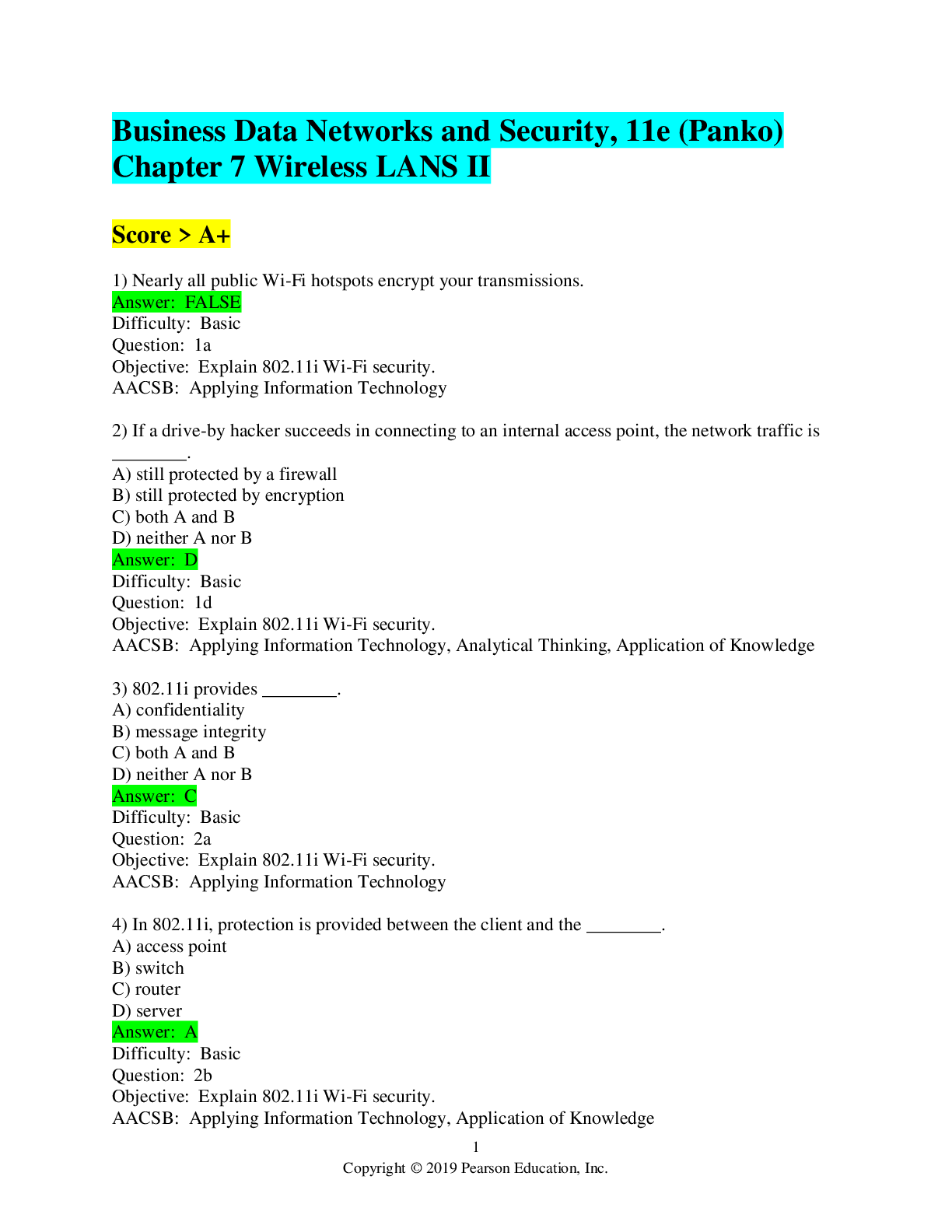
Reviews( 0 )
Recommended For You
Computer Networking> EXAM > Chapter 5 Ethernet (802.3) Switched LANs >Business Data Networks and Security, 11e (Panko) > 2023 > Score A+ (All)
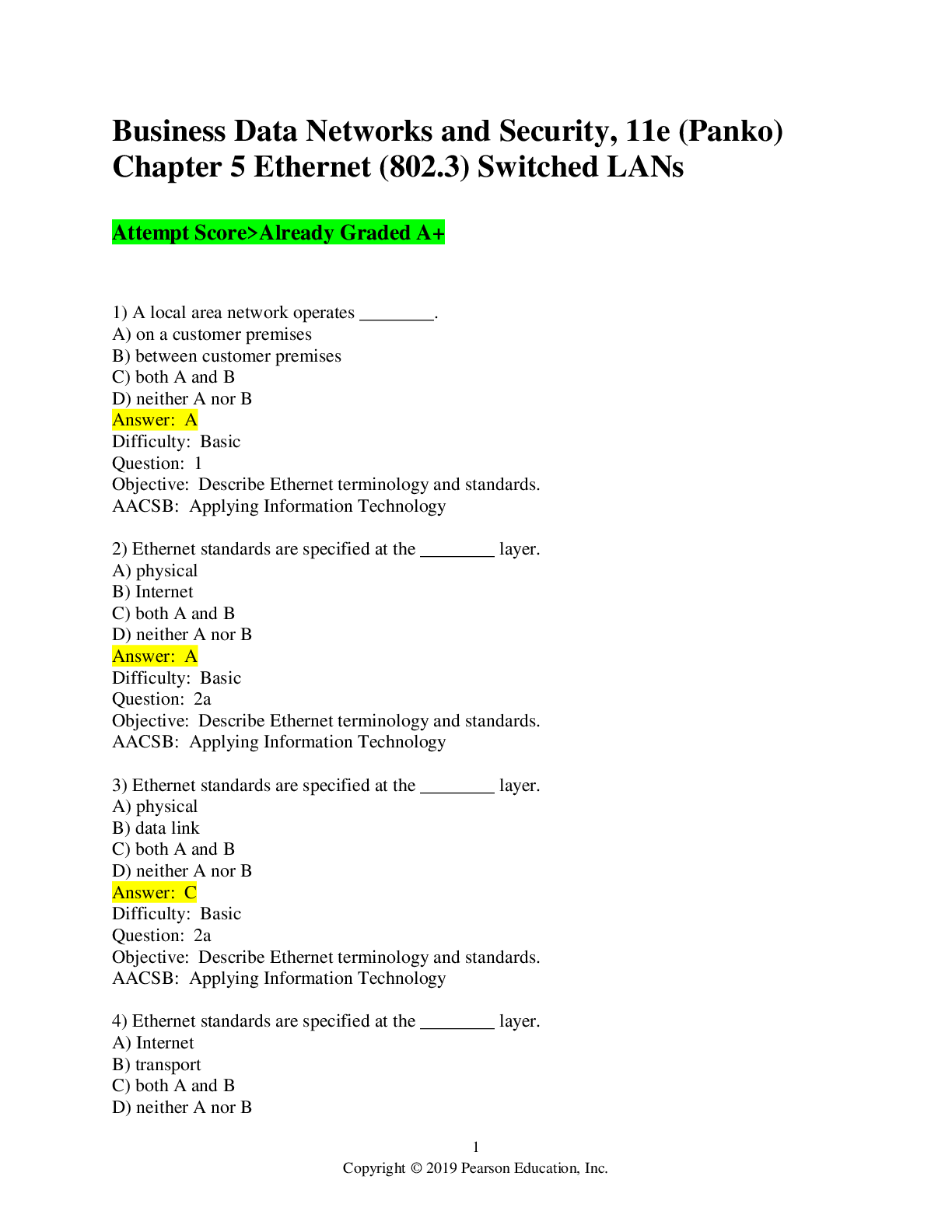
Chapter 5 Ethernet (802.3) Switched LANs >Business Data Networks and Security, 11e (Panko) > 2023 > Score A+
1) A local area network operates ________. A) on a customer premises B) between customer premises C) both A and B D) neither A nor B Difficulty: Basic Question: 1 Objective: Describe Ether net termino...
By Expert#1 , Uploaded: Sep 19, 2019
$7
Computer Networking> EXAM > Chapter 8 TCP/IP Internetworking I > Business Data Networks and Security, 11e (Panko) > Latest Exam > Score A+ (All)
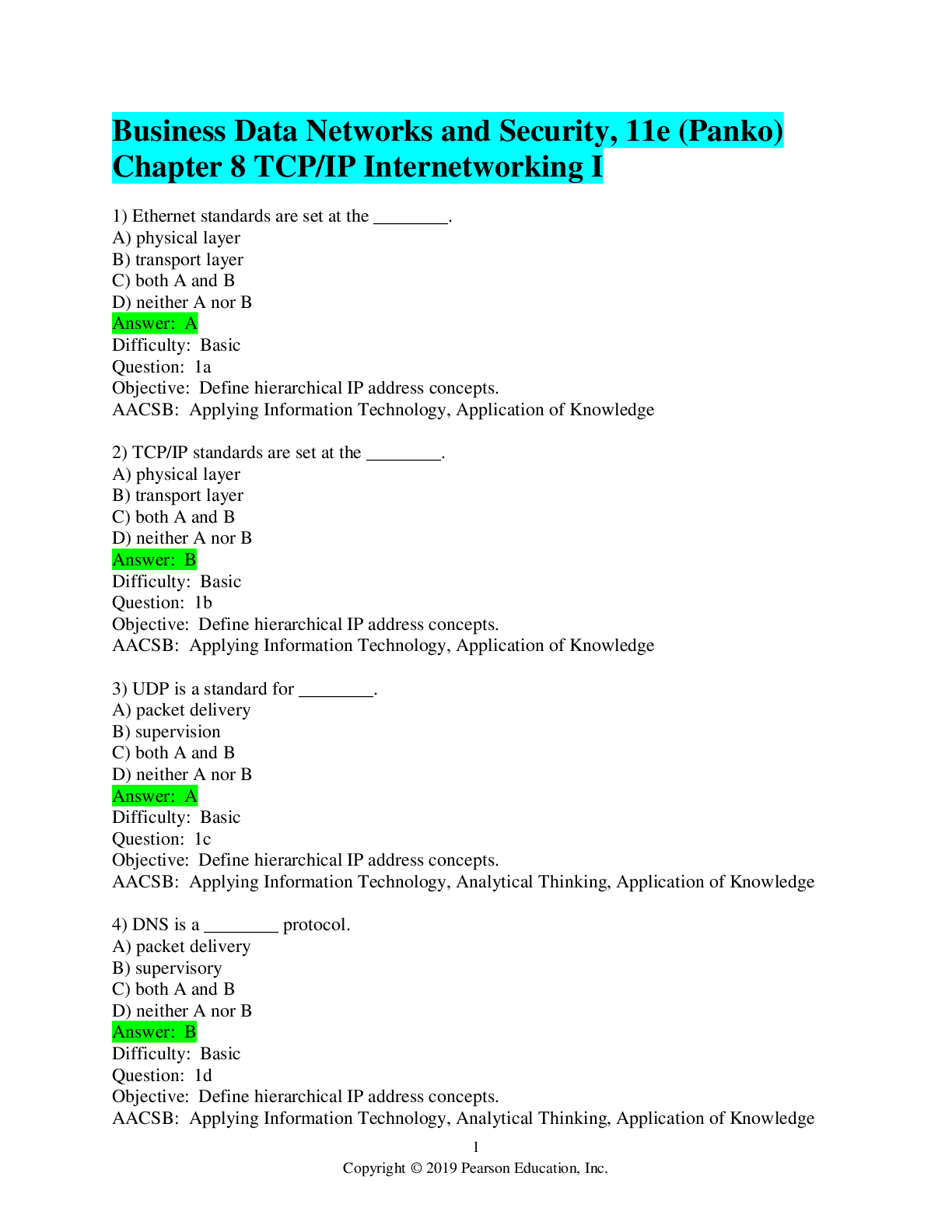
Chapter 8 TCP/IP Internetworking I > Business Data Networks and Security, 11e (Panko) > Latest Exam > Score A+
1) Ethernet standards are set at the ________. A) physical layer B) transport layer C) both A and B D) neither A nor B Difficulty: Basic Question: 1a Objective: Define hierarchical IP address concepts...
By Expert#1 , Uploaded: Sep 19, 2019
$8.5
Business Management> EXAM > Business Data Networks and Security, 11e (Panko) Appendix: Managing the Security Process>Attempt Score-All the Answers Correct {100% (All)
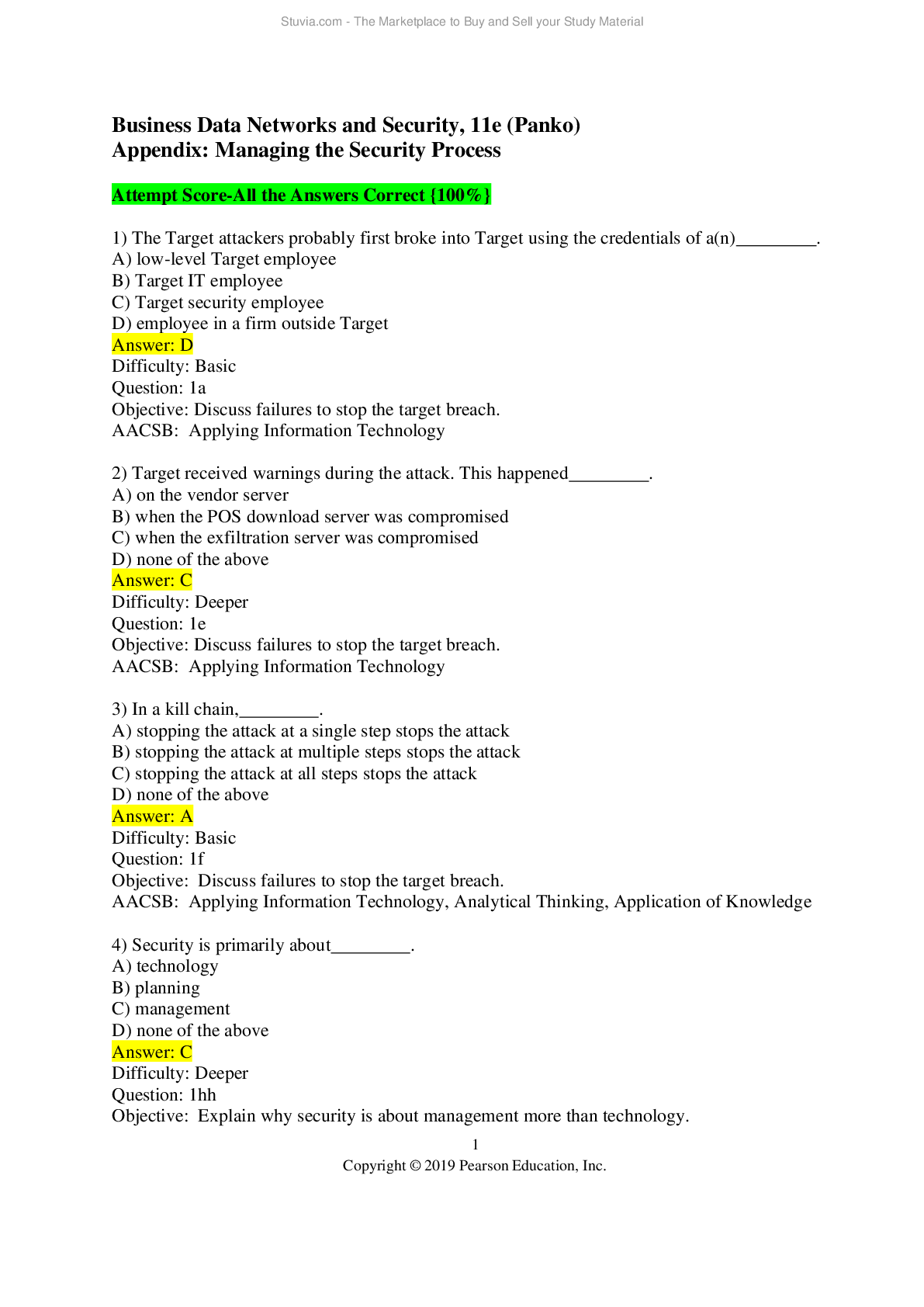
Business Data Networks and Security, 11e (Panko) Appendix: Managing the Security Process>Attempt Score-All the Answers Correct {100%
Business Data Networks and Security, 11e (Panko) Appendix: Managing the Security Process>Attempt Score-All the Answers Correct {100%
By QUIZ BIT , Uploaded: Jun 03, 2021
$10
Computer Networking> EXAM > Business Data Networks and Security, 11e (Panko) Chapter 4 Network Security (2019 Latest) Already Graded {A+} (All)
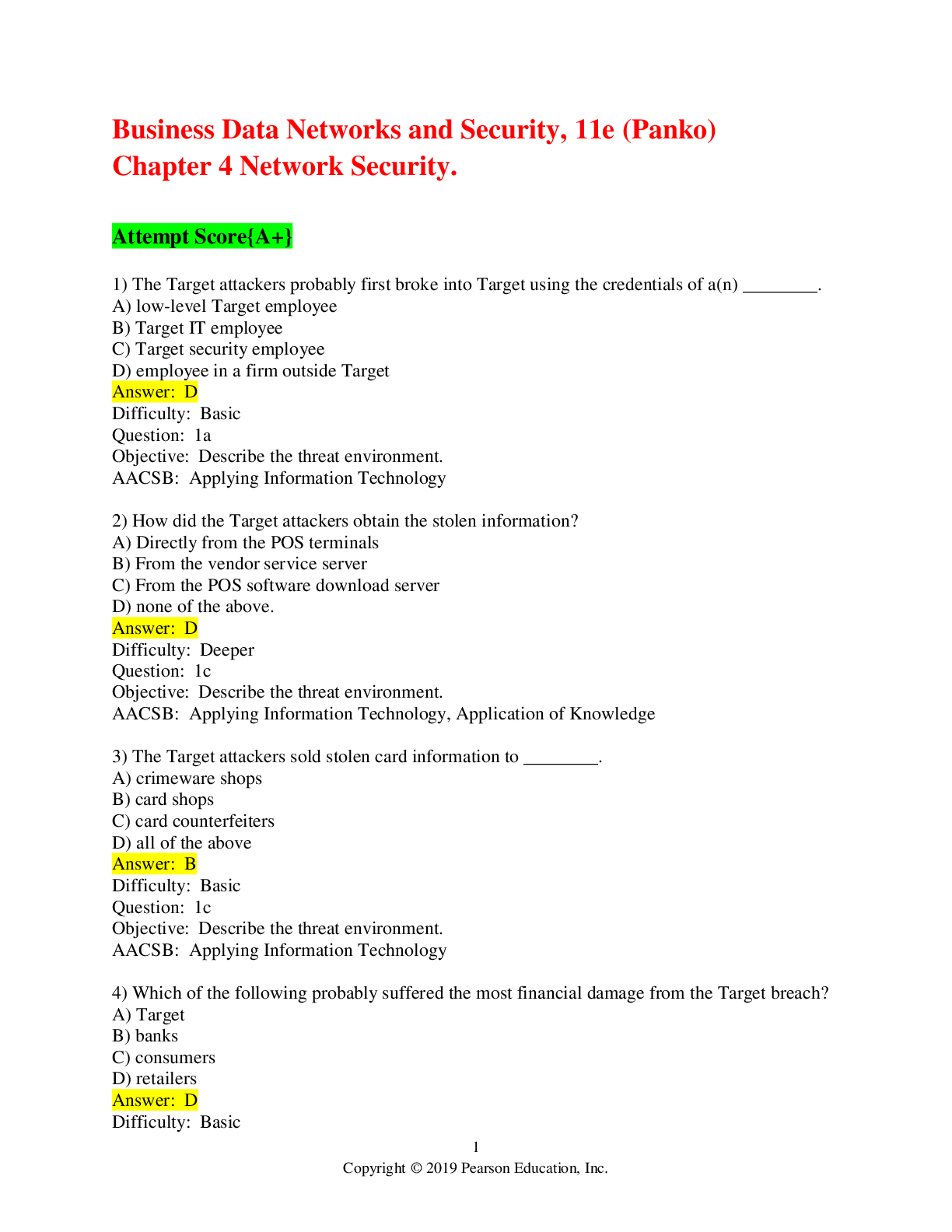
Business Data Networks and Security, 11e (Panko) Chapter 4 Network Security (2019 Latest) Already Graded {A+}
1) The Target attackers probably first broke into Target using the credentials of a(n) ________. A) low-level Target employee B) Target IT employee C) Target security employee D) employee in a fir...
By Expert#1 , Uploaded: Sep 19, 2019
$12
Computer Networking> EXAM > Chapter 6 Wireless LANS I > Business Data Networks and Security, 11e (Panko) > 2019 Latest Exam > Already Graded A (All)
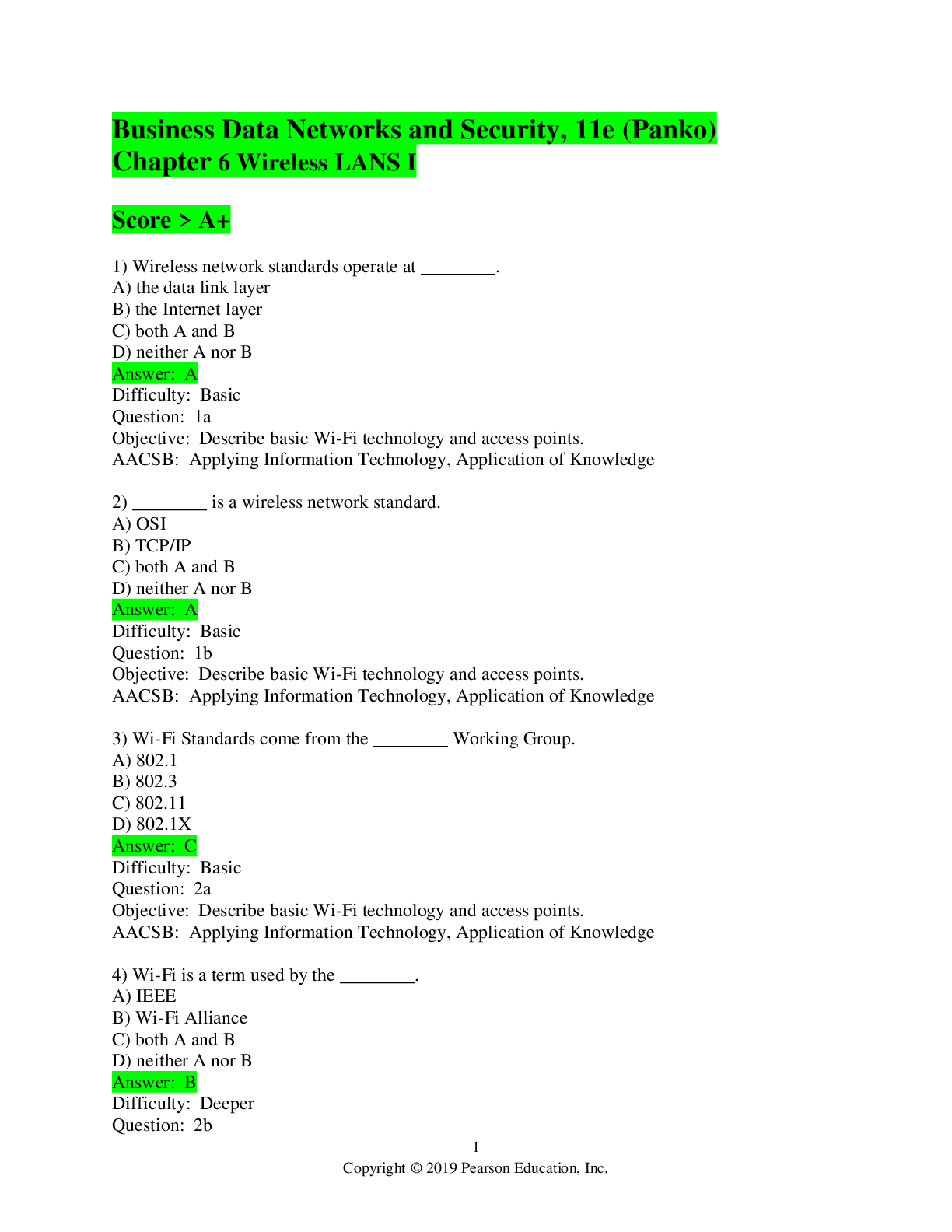
Chapter 6 Wireless LANS I > Business Data Networks and Security, 11e (Panko) > 2019 Latest Exam > Already Graded A
1) Wireless network standards operate at ________. A) the data link layer B) the Internet layer C) both A and B D) neither A nor B Difficulty: Basic Question: 1a Objective: Describe basic Wi...
By Expert#1 , Uploaded: Sep 19, 2019
$10
Computer Networking> EXAM > Business Data Networks and Security, 11e (Panko) Chapter 2 Network Standards>Attempt score-100% correct (All)

Business Data Networks and Security, 11e (Panko) Chapter 2 Network Standards>Attempt score-100% correct
Business Data Networks and Security, 11e (Panko) Chapter 2 Network Standards 1) Internet standards are published as ________. A) RFCs B) IETFs C) TCP/IPs D) Internet Protocols Difficulty: Ba...
By Expert#1 , Uploaded: Sep 18, 2019
$10
Computer Networking> EXAM > Business Data Networks and Security, 11e (Panko)-Appendix: Managing the Security Process-Graded A+ (All)
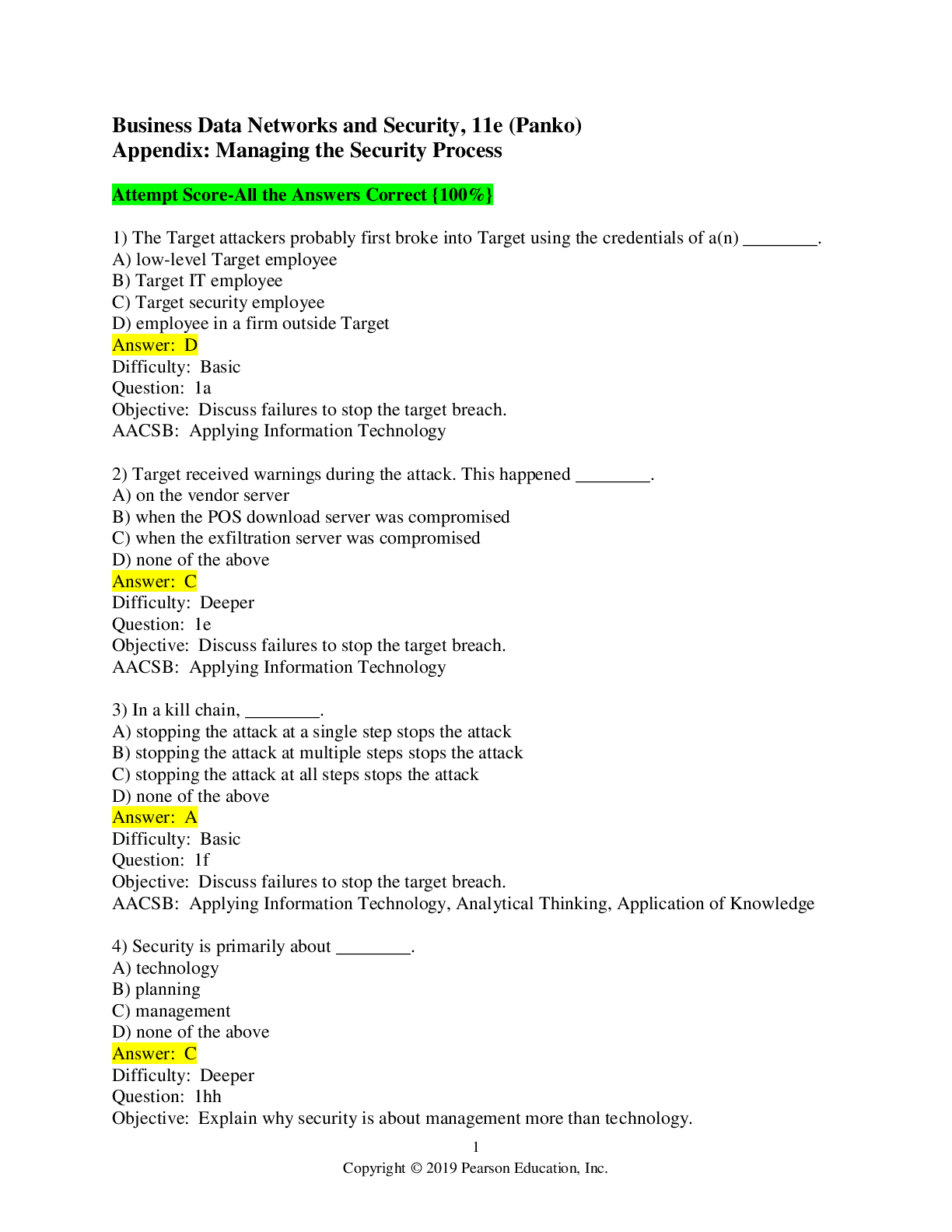
Business Data Networks and Security, 11e (Panko)-Appendix: Managing the Security Process-Graded A+
Business Data Networks and Security, 11e (Panko) Appendix: Managing the Security Process 1) The Target attackers probably first broke into Target using the credentials of a(n) ________. A) low-le...
By Expert#1 , Uploaded: Sep 19, 2019
$9.5
Computer Networking> EXAM > Business Data Networks and Security, 11e (Panko) > Chapter 1 Core Network Concepts and Terminology>2019>Scored A. (All)
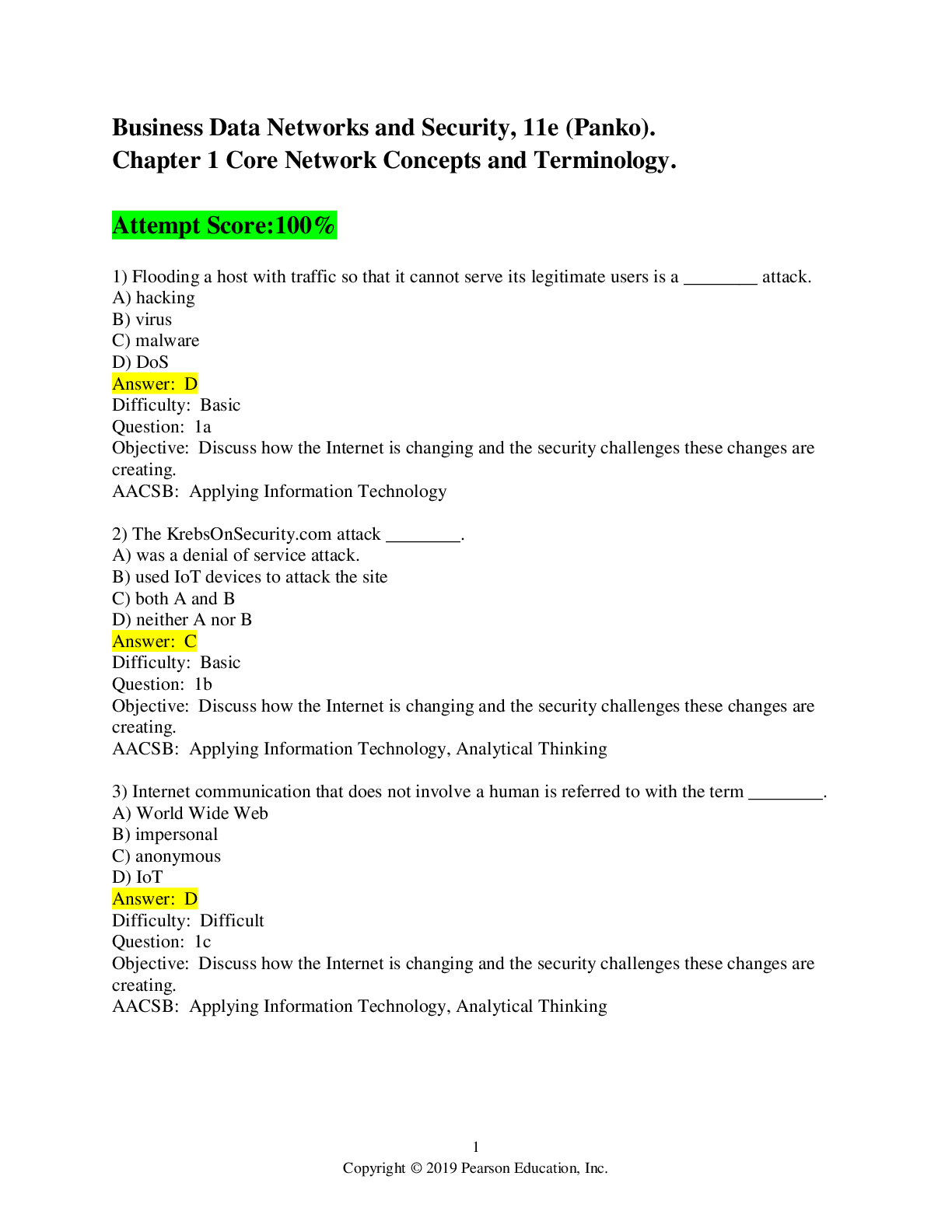
Business Data Networks and Security, 11e (Panko) > Chapter 1 Core Network Concepts and Terminology>2019>Scored A.
1) Flooding a host with traffic so that it cannot serve its legitimate users is a ________ attack. A) hacking B) virus C) malware D) DoS Difficulty: Basic Question: 1a Objective: Discuss how the Inter...
By Expert#1 , Uploaded: Sep 19, 2019
$9.5
Computer Networking> EXAM > Chapter 3 Network Management > Business Data Networks and Security, 11e (Panko)>Latest 2019>Already Graded A+ (All)
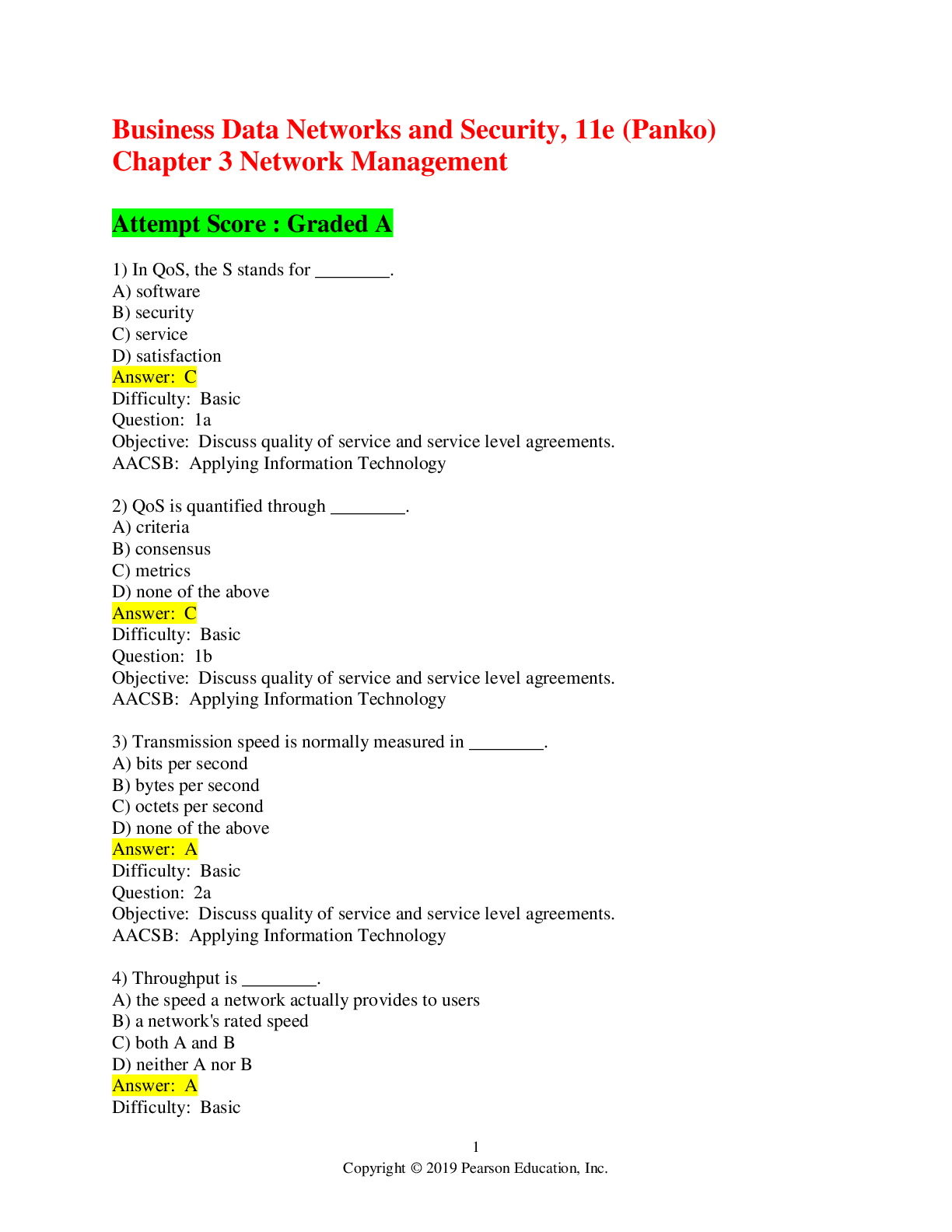
Chapter 3 Network Management > Business Data Networks and Security, 11e (Panko)>Latest 2019>Already Graded A+
1) In QoS, the S stands for ________. A) software B) security C) service D) satisfaction Difficulty: Basic Question: 1a Objective: Discuss quality of service and service level agreements. A...
By Expert#1 , Uploaded: Sep 19, 2019
$7.5
Business> EXAM > Business Data Networks and Security, 11e (Panko) Chapter 5 Ethernet (802.3) Switched LANs-with verified answers-2022-2023 (All)
 Chapter 5 Ethernet (802.png)
Business Data Networks and Security, 11e (Panko) Chapter 5 Ethernet (802.3) Switched LANs-with verified answers-2022-2023
Business Data Networks and Security, 11e (Panko) Chapter 5 Ethernet (802.3) Switched LANs-with verified answers-2022-2023 1) A local area network operates . A) on a customer premises B) between c...
By Studyrepository , Uploaded: Nov 02, 2022
$8
Document information
Connected school, study & course
About the document
Uploaded On
Sep 19, 2019
Number of pages
19
Written in
Additional information
This document has been written for:
Uploaded
Sep 19, 2019
Downloads
0
Views
292






